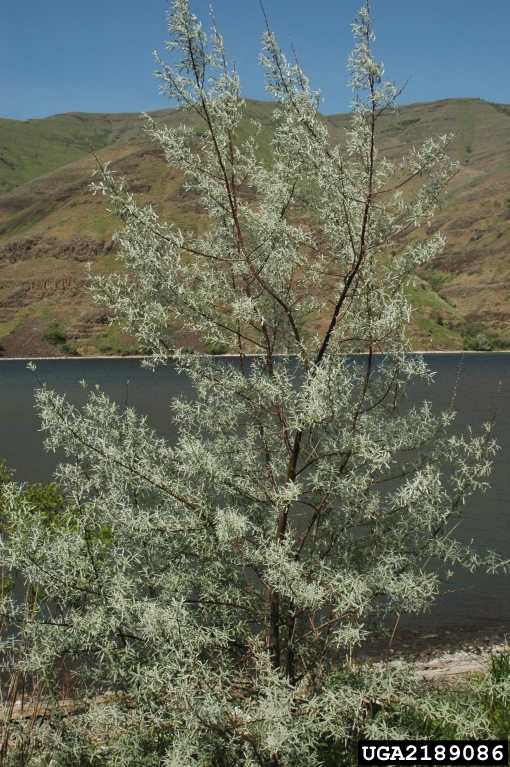Weed of the Month: Russian Olive
 | Author:
Allison Kosto, MSU Broadwater County Extension Agent
MSU Broadwater County Extension Agent |
Weed of the Month: Russian Olive
Allison Kosto
MSU Broadwater County Extension Agent
This weed of the month, Russian olive, is another plant that many people have a love and hate relationship with. Since 2010, it has been listed on the Montana Department of Agriculture's noxious weed list as a regulated plant. This means it is illegal to intentionally spread or sell. However, I get calls at least once a year from someone who would like to know where to buy them. One person even asked if it was okay to dig them up on the side of the road and transplant them on his property. The answer to that question is a resounding no. Here is why.
Description & Habitat
Native to Eurasia, Russian olive was brought to North America during colonial times and moved west with settlers. It is known for its ability to thrive in arid environments. It was used extensively in windbreaks as well as ornamental plantings. By the early 1900s, it was present in most western states. You can still see many windbreaks today with Russian Olives that were planted in the mid-1900s.
However, it quickly escaped cultivation and became a weedy species. It is known for taking over seasonal riparian areas. A perfect example is in the wildlife management area just north of Townsend on the south side of Canyon Ferry which is now dominated by Russian olive. The plant is highly competitive and can displace native vegetation including willows and cottonwoods. Growth along waterways can restrict and reduce water flow. Russian olive branches have thorns that can interfere with human, livestock and wildlife movement.
Russian olive is a large shrub or small tree, up to 25 feet in height. It often forms dense thickets. Leaves are 2 to 3 inches long and an inch or less in width. The upper leaf surface is green-gray while the lower surface is silver-gray. Branches are reddish-brown, and each branch has 1-to-2-inch thorns. Russian olive has thin bark that comes off in narrow, fibrous strips. It has small yellow bell-shaped flowers that appear in May and June. The flowers transition to small olive-shaped fruits; Each with a single seed. Fruits start silver and become brown as they mature. Birds consume the seeds and transport them to new areas. Roots are capable of fixing nitrogen and are known for sending up suckers.
Management
Russian olive is difficult to control once established. Plants can regrow when disturbed from roots and even directly from cut stumps. The most effective technique is to prevent establishment. If you find a new establishment, act quickly.
It typically takes several methods for full control. Prescribed fire and grazing with goats can be used for suppression but will not fully control it. Although not always practical, mowing can be used on young saplings. It will be necessary to repeat multiple times. Large trees should be cut down. Since the tree can regrow from the stump, the stump needs to be completely removed or treated with an herbicide.
Cut stump herbicide applications should be done to the stump surface immediately after removing the top growth. Most commonly used chemicals for stump treatments include Arsenal, Garlon, Habitat and Remedy. Crossbow can be used as a bark treatment which is an herbicide application made to the lower 2 feet of the tree. Another option is a foliar herbicide with 2,4-D, Crossbow, Rodeo or Roundup. Always read and follow the entire label when applying herbicides. Rodeo and Habitat are the only products listed that can be used in or around water. Common chemical names are used for clarity but does not imply endorsement of a product or brand.
It is important to note that as a regulated plant, you are not required to control Russian olive on your property like you would for a noxious weed such as spotted knapweed. However, it is still illegal to intentionally spread it. For assistance on weed identification and management, contact the MSU Extension Office in Broadwater County at 406-266-9242 or allison.kosto@montana.edu.
Article Images
Click on Image Thumbnail(s) to view fullsize image
PhotoCredit: Photo Credits: Allison Kosto
Image 1 Caption: Russian Olive
Photo Credits: Allison Kosto
